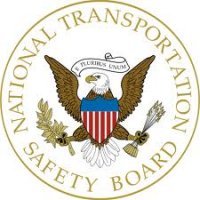NTSB Issues Safety Alert to Pilots on Midair Collision Prevention

The National Transportation Safety Board issued a Safety Alert Tuesday to pilots with suggestions on what they can do to reduce their chances of being involved in a midair collision.
In an effort to illustrate the limitations of the “see and avoid” concept of aircraft separation, the NTSB created a series of animations depicting the pilots’ visual field of view from each of the four airplanes involved in two midair collisions that were investigated by the NTSB in 2015.
The animations show how difficult it can be for pilots to spot converging aircraft that may present a midair collision risk in a dynamic visual environment.
Using 3-D laser equipment, investigators scanned the cockpit windows and surrounding airplane structure of four exemplar airplanes involved in the two midair collisions to create animations that, combined with radar data, provided an approximation of what each pilot likely saw before the crashes. Investigators also used radar data to reconstruct how in-cockpit technology that provides pilots with graphical and aural alerts of nearby traffic could have made the pilots aware of the approaching aircraft and possibly prevented the collisions.
“These accidents and the animations clearly demonstrate the safety benefit of augmenting pilots’ vision with technological safety nets,” said NTSB Chairman Christopher A. Hart. “Technologies in the cockpit that warn of traffic conflicts through displays or alerts can help pilots become aware of, and maintain separation from, nearby aircraft, even if they have difficulty seeing them.”
On July 7, 2015, a Cessna 150 that had just departed from Moncks Corner, South Carolina, and an F-16 Air Force fighter jet on a training mission collided. An air traffic controller advised the F-16 pilot that the Cessna was a potential traffic conflict. The F-16 pilot was not able to visually acquire the Cessna until it was too late to avoid the collision. The two occupants of the Cessna were killed; the F-16 pilot ejected and survived. The NTSB determined that the probable cause of the crash was the air traffic controller’s failure to provide an appropriate resolution to the traffic conflict.
On August 16, 2015, a North American Rockwell Sabreliner inbound for landing at Brown Field Municipal Airport in San Diego and a Cessna 172 that was practicing landings at the same airport collided. The four occupants of the Sabreliner and the sole occupant of the Cessna were killed. A cockpit visibility study revealed the fields of view of both pilots were limited and partially obscured at times. The NTSB determined that the probable cause of the accident was the air traffic controller’s failure to properly identify the aircraft in the pattern and to ensure control instructions were being performed.
The NTSB said that contributing to both accidents were the inherent limitations of the “see and avoid” concept of traffic separation. These limitations, combined with errors by the air traffic controllers, resulted in the pilots’ inability to take action to avoid the collisions.
The Safety Alert highlights the value of traffic avoidance technologies to pilots as an aid to detecting and avoiding other airplanes in flight. Such technologies also serve as another layer of safety in the case of air traffic control errors, such as those referenced in the two accidents above.
In addition to issuing the Safety Alert, the NTSB made recommendations to the Federal Aviation Administration and the three companies operating federal contract control towers in the U.S., asking them to brief air traffic controllers on the errors in the two midair collisions and to include these accidents as examples in initial and recurrent training.
The Safety Alert, Prevent Midair Collisions: Don’t Depend on Vision Alone, the animations, safety recommendation report, accident reports, and are all available at http://go.usa.gov/x8c5G




.jpg)



.png)
Comments
There are no comments yet for this item
Join the discussion